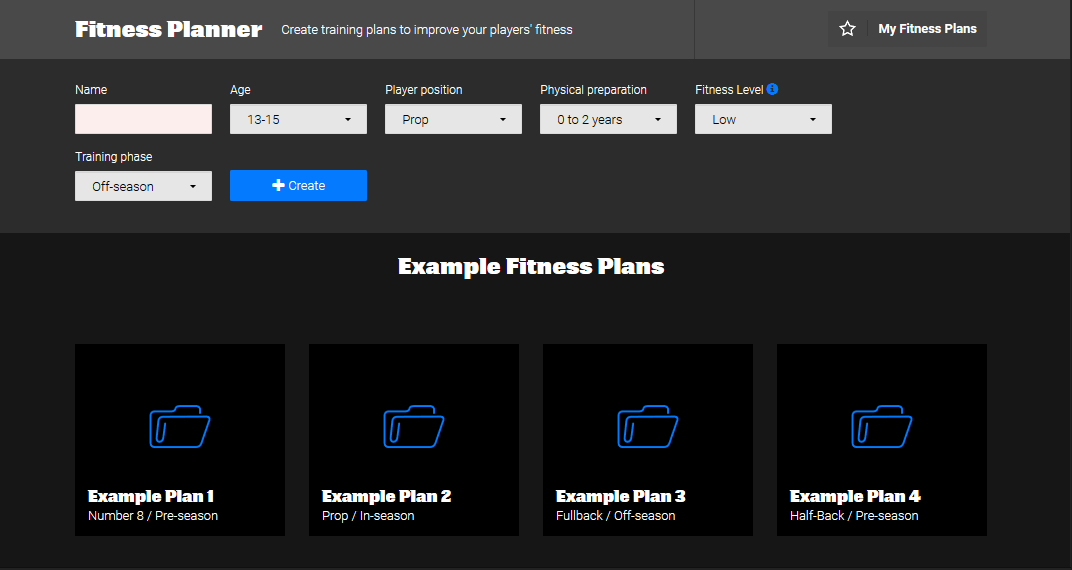- Rugby Toolbox
- RugbySmart
- RugbySmart information
- Prepare Players Properly
Prepare Players Properly
CONDITIONING
Players often begin the season without the right fitness and conditioning. Preparation is the key to staying on the field and that means assessing, treating and managing any injuries.
It's crucial that players follow a good pre-season strength and conditioning programme. That way they hit the ground running when the whistle blows.
So, what are the components of physical conditioning?
• Speed = coordinating simple or complex limb movements at high speed.
• Strength = the maximum force a player can exert against an external force.
• Endurance = measures the body’s ability to maintain a high work rate.
• Functional competence = measures the player’s stability and mobility during movements related rugby.
• Power = speed x strength
Rugby players require different amounts of strength, power, endurance, speed and agility. There aren’t many team sports that require such a diverse and comprehensive range of physical attributes.
The unique demands of different positions should also influence how you train.
This is why there are FREE positional fitness programmes available for players on this site.
There are a number of variables to consider:
• The player’s age
• Training experience
• Position
• Long-term and short-term goals
• And the availability of facilities and resources
The other key consideration is the timing of the Rugby season.
• Off-season
• Pre-season
• In-season
PHYSICAL ASSESSMENT
In general, it is helpful to test for strength, flexibility, balance, speed, aerobic and anaerobic endurance, as well as anatomical and biomechanical abnormalities.
PHYSICAL ASSESSMENT |
TEST |
| Aerobic endurance | Bronco test |
| Speed |
Forwards: 10m and 20m sprints X 2 Backs: 10m, 20m, 40m sprints X 2 |
| Core | Plank - 3min hold |
| Upper body strength | Maximum number of press ups |
AEROBIC ENDURANCE
HOW IT WORKS
The player runs run shuttles of 20, 40 and then 60 metres. This set is then repeated five times. The goal is to do this as quickly as possible.
To give you an indication of what great looks like, Richie McCaw managed a personal best in the Bronco fitness test of four min 56 sec.
This tests players’ anaerobic capacity, motor skills, running efficiency and turning ability.
The whole team can do the test together and work to maximum effort by motivating one another.
SET UP
- Use a flat well-maintained playing field or artificial surface
- You need cones at 20m, 40m and 60m.
- Players run to the 20m cone, turn around and come back to the start.
- Players run to the 40m cone, turn around and come back to the start
- Players run to the 60m cone, turn around and come back to the start.
- This is repeated five times.
- Time your players and note this down.
We would advise giving 5-10 minutes’ rest post-test before continuing with a fitness/rugby session.
SPEED
Record the timings for the following sprints.
- Forwards: 10m and 20m sprints X 2
- Backs: 10m, 20m, 40m sprints X 2
CORE
Ask your players to hold a plank for 3 minutes. If they are unable to hold for this length of time, record the time that they achieved.
UPPER BODY STRENGTH
Ask your players to do as many press ups as they can. Record the number of press ups achieved.
THROUGHOUT THE SEASON
These tests provide a baseline measure at the start of the pre-season and then can be placed at 4-6 week intervals throughout the season to see how players are progressing.
WARM UP
The warm-up should last between 10 and 20 minutes, depending on the activity to follow. It must be versatile enough to meet the demands of a competitive match or training session.
The warm-up should start off at low intensity. Then gradually progress from a simple series of movements to a more specific and higher intensity level. This helps players prepare muscles and joints to move at the speed and intensity of the following game or training.
The key benefits warming up are:
• Raising the body temperature so muscles become more elastic, and more efficient
• Stimulating the heart and lungs, so pulse and breathing rates increase
• Activating relevant muscle groups
• Improving reaction speeds by stimulating the nervous system
• Improving co-ordination
• Enabling players to prepare mentally
There are four stages to a complete warm-up:
1. AEROBIC EXERCISE: 5–10 minutes of non-specific exercise, like light jogging, to bring the body up to its optimum working temperature. Light sweating is usually an indication of a good aerobic work-out.
2. MOBILITY EXERCISES: taking the body through the full range of movements. Basic movements to loosen up the muscles and joint mobility. Use dynamic stretches like squats and lunges because static stretches may be counterproductive.
3. PREPARATION FOR CONTACT: Neck, arm, core and shoulder work. Slowly introduce body contact, progressively increasing the intensity.
4. SPECIFIC EXERCISES: practise the basic rugby movements and skills using simulated activities. For example the kickers should have a leg warm up routine.
Check out the SMALL BLACKS WARM UP HERE
Check out the TEENAGE WARM UP HERE
Check out the WOMEN AND GIRLS LOWER BODY WARM UP HERE
Check ou the WOMEN AND GIRLS NECK WARM UP HERE
COOL-DOWN & RECOVERY
Cooling down is an important but often neglected part of training and playing. The length of the cool-down depends on the intensity of the workout. Generally, 5-10 minutes of low-intensity exercise is sufficient.
Cooling down gradually returns the body to its resting state, and helps flush waste products like lactic acid out of the muscles, reducing stiffness.
Stretching muscles during the cool-down is also important, as cooling muscles shorten rapidly, potentially reducing flexibility. That’s why a cool-down is a good opportunity to work on improving flexibility. A player should hold each stretch for 10-30 seconds, for two or three times on each limb.
And don’t forget to rehydrate – this is just as important.
HYDRATION
Water is essential for the body to function. During exercise, the major water loss from the body is through sweat. Water loss significantly reduces performance, so that sweat needs to be  replaced. Drink water before, during and after matches or trainings.
replaced. Drink water before, during and after matches or trainings.
As a rule:
- Drink 200-500ml during warm-up
- Drink 120-150ml during game breaks
- Drink 200-500ml during cool-down
- After game drink another 1L
An easy way to check your hydration level is to observe the colour of your urine. Lemonade great but orange juice equals dehydration.
NUTRITION
It’s important to find the right balance between fats, carbohydrates and protein so that your body has enough fuel to last, not only a game - but also the training necessary to make it to that point.
It’s accepted that nutrition plays a vital role in performance, and that a player's requirements are different to that of a non-rugby player. A nutrition plan does more than just optimise energy levels for training and competition.
Energise
Carbohydrate is the most readily available source of energy for players, and should form the bulk of their calorie intake. Guidelines for pre-match meals include:
• eat a main meal at least three hours prior to kick-off, focusing on carbohydrate-rich foods like bread, potatoes and pasta, with a small amount of protein
• a small snack like a banana 1½ hours before kick-off
• avoid very high protein and fat intakes
• drink plenty of fluid
• experiment with foods during training to find what suits you best
Build and Repair
Rugby is a high-contact sport requiring strength and power. Players need a higher intake of protein compared to non-players. Increasing muscle mass depends on a moderate level of protein, and other nutrients like fats and carbohydrates. These all add up to a positive energy balance.
Too nervous to eat? Some players find it too difficult to eat normally before a game. In these cases players should focus on foods that they enjoy and perhaps have a larger breakfast. An energy shake might be a good option as well.
Replenish
Within 40 minutes of the match finishing, players should replenish carbohydrates, fluids and electrolytes. A small amount of protein will also help recovery and energy.
Breakfast
Quality breakfast foods like porridge kickstart your metabolism and give your body what it needs to help burn calories throughout the day.
Snack Right
To stop you fading between meals, it’s important to tuck into some healthy snacks. Think high nutrition foods such as almonds, walnuts, Greek yoghurt, eggs, fruit etc.
Post training
As part of a good diet, eating foods high in protein such as dairy, fish, lean meats and chicken, eggs, nuts and peanut butter can help maintain and repair your muscles while carbohydrates including fruit, vegetables and grains are needed to replace the energy you just used up at training.
Try to choose wholegrains such as brown rice, oatmeal and whole wheat bread to give you the energy you need whilst also providing fibre and other nutrients you need to be healthy.
On Game Day 
Make sure you eat 2 to 4 hours before the game. Choose a meal high in protein and carbs – like a chicken sandwich, cereal and milk, chicken noodle soup and yoghurt or pasta with tomato sauce.
It's important to have a light snack like fruit or vegetables, crackers, bagels or low-fat yoghurt about 2 hours before a game – any closer you might feel full or a bit sick when you play.